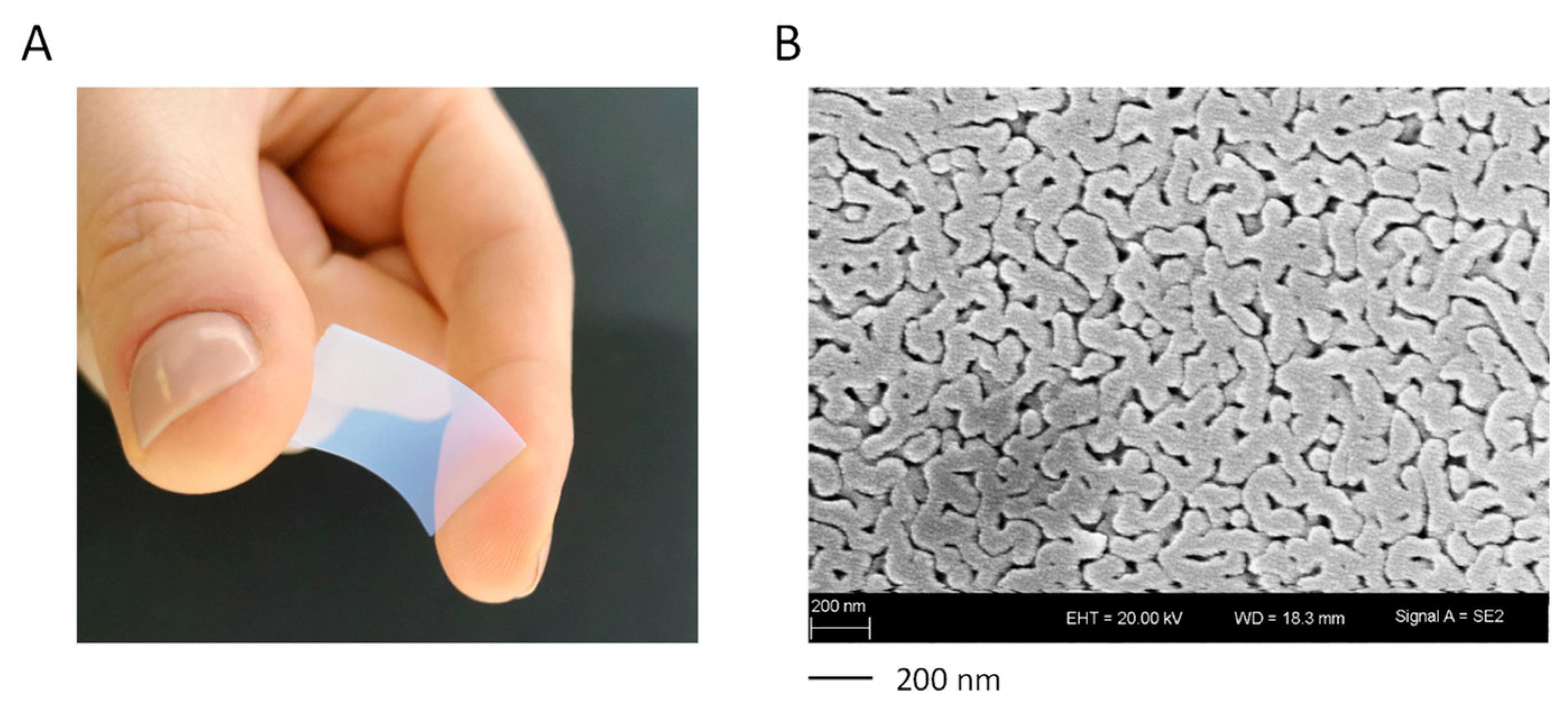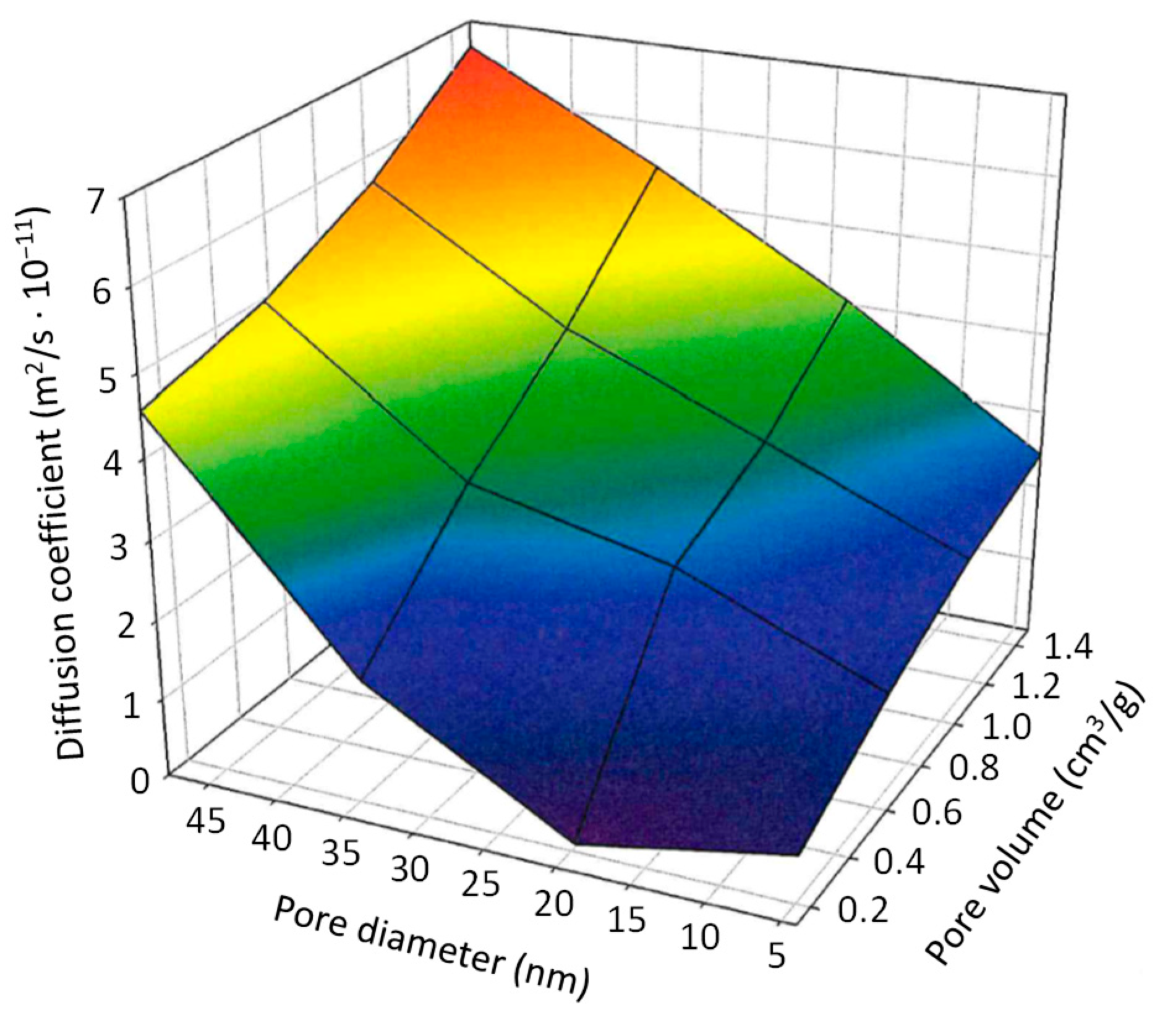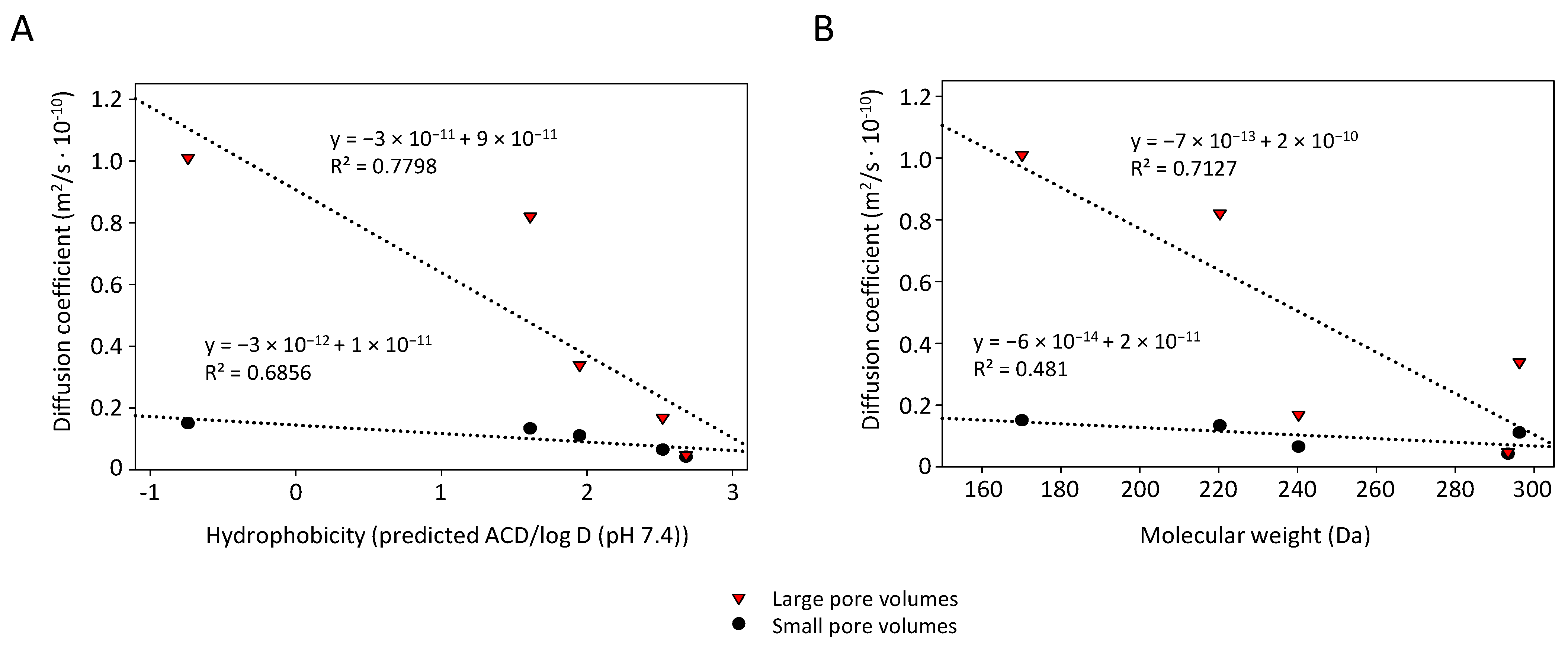Characterization of Drug Release from Mesoporous SiO2-Based Membranes with Variable Pore Structure and Geometry
Abstract
:1. Introduction
2. Materials and Methods
2.1. Materials
2.2. Preparation of Mesoporous Membranes
2.3. Characterization of Mesoporous Membranes
2.4. Membrane Loading and Drug Release
2.5. Determination of Drug Concentrations
2.6. Calculation of Diffusion Coefficients
3. Results
3.1. Properties and Characterization of Mesoporous Membranes
3.2. Characterization of Drug Loading Properties: Effects of Pore Volume, Pore Surface and Loading Concentration
3.3. Drug Release Properties as Function of Various Mesoporous Membrane Properties
3.4. Lateral Diffusion within Mesoporous Membranes
3.5. Dependence of Loading and Release Characteristics on Drug Properties
4. Discussion
Supplementary Materials
Author Contributions
Funding
Institutional Review Board Statement
Informed Consent Statement
Data Availability Statement
Acknowledgments
Conflicts of Interest
References
- Tanwar, H.; Sachdeva, R. Transdermal drug delivery system: A review. Int. J. Pharm. Sci. Res. 2016, 7, 2274–2290. [Google Scholar]
- Alkilani, A.Z.; McCrudden, M.T.; Donnelly, R.F. Transdermal Drug Delivery: Innovative Pharmaceutical Developments Based on Disruption of the Barrier Properties of the stratum corneum. Pharmaceutics 2015, 7, 438–470. [Google Scholar] [CrossRef] [PubMed] [Green Version]
- Miller, K. Transdermal patches: Past, present and future. Ther. Deliv. 2015, 6, 639–641. [Google Scholar] [CrossRef] [Green Version]
- Arora, A.; Prausnitz, M.R.; Mitragotri, S. Micro-scale devices for transdermal drug delivery. Int. J. Pharm. 2008, 364, 227–236. [Google Scholar] [CrossRef] [Green Version]
- Prausnitz, M.R.; Langer, R. Transdermal drug delivery. Nat. Biotechnol. 2008, 26, 1261–1268. [Google Scholar] [CrossRef] [PubMed]
- Jeong, W.Y.; Kwon, M.; Choi, H.E.; Kim, K.S. Recent advances in transdermal drug delivery systems: A review. Biomater. Res. 2021, 25, 24. [Google Scholar] [CrossRef]
- Chatterjee, S.; Hui, P.C.-L.; Kan, C.-W. Thermoresponsive Hydrogels and Their Biomedical Applications: Special Insight into Their Applications in Textile Based Transdermal Therapy. Polymers 2018, 10, 480. [Google Scholar] [CrossRef] [Green Version]
- Evanghelidis, A.; Beregoi, M.; Diculescu, V.C.; Galatanu, A.; Ganea, P.; Enculescu, I. Flexible Delivery Patch Systems based on Thermoresponsive Hydrogels and Submicronic Fiber Heaters. Sci. Rep. 2018, 8, 17555. [Google Scholar] [CrossRef] [Green Version]
- Wiedersberg, S.; Guy, R.H. Transdermal drug delivery: 30+ years of war and still fighting! J. Control Release 2014, 190, 150–156. [Google Scholar] [CrossRef] [PubMed] [Green Version]
- Pastore, M.N.; Kalia, Y.N.; Horstmann, M.; Roberts, M.S. Transdermal patches: History, development and pharmacology. Br. J. Pharmacol. 2015, 172, 2179–2209. [Google Scholar] [CrossRef] [PubMed] [Green Version]
- Regenthal, R.; Voskanian, M.; Baumann, F.; Teichert, J.; Bratter, C.; Aigner, A.; Abraham, G. Pharmacokinetic evaluation of a transdermal anastrozole-in-adhesive formulation. Drug Des. Dev. Ther. 2018, 12, 3653–3664. [Google Scholar] [CrossRef] [Green Version]
- Zhu, Y.; Shi, J.; Shen, W.; Chen, H.; Dong, X.; Ruan, M. Preparation of novel hollow mesoporous silica spheres and their sustained-release property. Nanotechnology 2005, 16, 2633–2638. [Google Scholar] [CrossRef]
- Almomen, A.; El-Toni, A.M.; Badran, M.; Alhowyan, A.; Abul Kalam, M.; Alshamsan, A.; Alkholief, M. The Design of Anionic Surfactant-Based Amino-Functionalized Mesoporous Silica Nanoparticles and their Application in Transdermal Drug Delivery. Pharmaceutics 2020, 12, 1035. [Google Scholar] [CrossRef] [PubMed]
- Vallet-Regi, M.; Rámila, A.; del Real, R.P.; Pérez-Pariente, J. A New Property of MCM-41: Drug Delivery System. Chem. Mater. 2001, 13, 308–311. [Google Scholar] [CrossRef]
- Huang, X.; Young, N.P.; Townley, H.E. Characterization and Comparison of Mesoporous Silica Particles for Optimized Drug Delivery. Nanomater. Nanotechnol. 2014, 4, 1–15. [Google Scholar] [CrossRef]
- Pinto Reis, C.; Neufeld, R.J.; Ribeiro, A.J.; Veiga, F.; Nanoencapsulation, I. Methods for preparation of drug-loaded polymeric nanoparticles. Nanomed. Nanotechnol. Biol. Med. 2006, 2, 8–21. [Google Scholar] [CrossRef] [Green Version]
- Enke, D.; Janowski, F.; Schwieger, W. Porous glasses in the 21st century––A short review. Microporous Mesoporous Mater. 2003, 60, 19–30. [Google Scholar] [CrossRef]
- Inayat, A.; Reinhardt, B.; Uhlig, H.; Einicke, W.D.; Enke, D. Silica monoliths with hierarchical porosity obtained from porous glasses. Chem. Soc. Rev. 2013, 42, 3753–3764. [Google Scholar] [CrossRef]
- Inayat, A.; Reinhardt, B.; Herwig, J.; Küster, C.; Uhlig, H.; Krenkel, S.; Raedleind, E.; Enke, D. Recent advances in the synthesis of hierarchically porous silica materials on the basis of porous glasses. New J. Chem. 2016, 40, 4095–4114. [Google Scholar]
- Bauer, F.; Meyer, R.; Czihal, S.; Bertmer, M.; Decker, U.; Naumov, S.; Uhlig, H.; Steinhart, M.; Enke, D. Functionalization of porous siliceous materials, Part 2: Surface characterization by inverse gas chromatography. J. Chromatogr. A 2019, 1603, 297–310. [Google Scholar] [CrossRef] [PubMed]
- Landers, J.; Gor, G.Y.; Neimark, A.V. Density functional theory methods for characterization of porous materials. Colloids Surf. A Physicochem. Eng. Asp. 2013, 437, 3–32. [Google Scholar] [CrossRef]
- Brunauer, S.; Emmett, P.H.; Teller, E. Adsorption of Gases in Multimolecular Layers. J. Am. Chem. Soc. 1938, 60, 309–319. [Google Scholar] [CrossRef]
- Keck, C.; Müller, R.H. Moderne Pharmazeutische Technologie [Modern Pharmaceutical Technology]. 2012. Available online: http://pharmazie-lehrbuch.de/ilb12/home.htm (accessed on 8 May 2022).
- Hood, H.P.; Nordberg, M.E. Treated Borosilicate Glass. U.S. Patent 2,106,744, 19 March 1934. Available online: https://patents.google.com/patent/US2106744A/en (accessed on 8 May 2022).
- Thommes, M.; Kaneko, K.; Neimark, A.V.; Olivier, J.P.; Rodriguez-Reinoso, F.; Rouquerol, J.; Sing, K.S.W. Physisorption of gases, with special reference to the evaluation of surface area and pore size distribution (IUPAC Technical Report). Pure Appl. Chem. 2015, 87, 1051–1069. [Google Scholar] [CrossRef] [Green Version]







| Drug | Therapeutic Use | Hydro-/Lipophilicity (log P) | Mol. Mass (g/mol) | Required Drug Levels |
|---|---|---|---|---|
| Anastrozole | Treatment of hormone-dependent breast cancer in postmenopausal women | lipophilic (2.68) | 293.37 | systemic; low |
| Xylazin | Veterinary medicine: sedative/analgesic/ muscle relaxant | intermediate (1.61) | 220.33 | systemic; low |
| Imiquimod | Immune modulator; superficial basal cell carcinoma, actinic keratosis, cutaneous warts | lipophilic (2.52) | 240.30 | local |
| Flunixin | Veterinary medicine: non-opioid analgesic | intermediate (1.95) | 296.25 | systemic; high |
| Levetiracetam | Antiepileptic (inhibitor of glutamate release) | hydrophilic (−0.74) | 170.21 | systemic; high |
| Designation | Pore Diameter (nm) | Pore Volume (cm3/g) | BET Surface Area (m2/g) | Thickness (µm) |
|---|---|---|---|---|
| CPG-300-0.13 | 9 | 0.13 | 137 | 300 |
| CPG-300-0.17 | 4 | 0.17 | 191 | 300 |
| CPG-300-0.18 | 4 | 0.18 | 154 | 300 |
| CPG-300-0.27 | 11 | 0.27 | 149 | 300 |
| CPG-300-0.29 | 41 | 0.29 | 27 | 300 |
| CPG-300-0.40 | 48 | 0.40 | 27 | 300 |
| CPG-300-0.67 | 37 | 0.67 | 113 | 300 |
| CPG-300-0.87 | 17 | 0.87 | 159 | 300 |
| CPG-300-1.12 | 17 | 1.12 | 240 | 300 |
| CPG-300-1.48 | 44 | 1.48 | 150 | 300 |
| CPG-200-0.16 | 7 | 0.16 | 121 | 200 |
| CPG-500-0.30 | 17 | 0.30 | 138 | 500 |
| CPG-500-0.19 | 28 | 0.19 | 66 | 500 |
| CPG-500-0.62 | 100 | 0.62 | 18 | 500 |
| Pore Architecture | 0.131 cm3/g and 9 nm (CPG-300-0.13) | 0.4 cm3/g and 48 nm (CPG-300-0.40) |
|---|---|---|
| Drug | ||
| Anastrozole | 0.0436 | 0.0510 |
| Flunixin | 0.0066 | 0.0392 |
| Levetiracetam | 0.0207 | 0.0374 |
| Imiquimod | 0.1117 | 0.0524 |
| Xylazine | 0.0172 | 0.0444 |
| Pore Architecture | 0.131 cm3/g and 9 nm (CPG-300-0.13) | 0.4 cm3/g and 48 nm (CPG-300-0.40) |
|---|---|---|
| Drug | ||
| Anastrozole | 4.25 × 10−12 m2/s | 4.82 × 10−11 m2/s |
| Flunixin | 1.11 × 10−11 m2/s | 3.39 × 10−11 m2/s |
| Levetiracetam | 1.51 × 10−11 m2/s | 1.01 × 10−10 m2/s |
| Imiquimod | 6.57 × 10−12 m2/s | 1.69 × 10−11 m2/s |
| Xylazine | 1.34 × 10−11 m2/s | 8.21 × 10−11 m2/s |
Publisher’s Note: MDPI stays neutral with regard to jurisdictional claims in published maps and institutional affiliations. |
© 2022 by the authors. Licensee MDPI, Basel, Switzerland. This article is an open access article distributed under the terms and conditions of the Creative Commons Attribution (CC BY) license (https://creativecommons.org/licenses/by/4.0/).
Share and Cite
Baumann, F.; Paul, T.; Wassersleben, S.; Regenthal, R.; Enke, D.; Aigner, A. Characterization of Drug Release from Mesoporous SiO2-Based Membranes with Variable Pore Structure and Geometry. Pharmaceutics 2022, 14, 1184. https://doi.org/10.3390/pharmaceutics14061184
Baumann F, Paul T, Wassersleben S, Regenthal R, Enke D, Aigner A. Characterization of Drug Release from Mesoporous SiO2-Based Membranes with Variable Pore Structure and Geometry. Pharmaceutics. 2022; 14(6):1184. https://doi.org/10.3390/pharmaceutics14061184
Chicago/Turabian StyleBaumann, Frank, Theresa Paul, Susan Wassersleben, Ralf Regenthal, Dirk Enke, and Achim Aigner. 2022. "Characterization of Drug Release from Mesoporous SiO2-Based Membranes with Variable Pore Structure and Geometry" Pharmaceutics 14, no. 6: 1184. https://doi.org/10.3390/pharmaceutics14061184
APA StyleBaumann, F., Paul, T., Wassersleben, S., Regenthal, R., Enke, D., & Aigner, A. (2022). Characterization of Drug Release from Mesoporous SiO2-Based Membranes with Variable Pore Structure and Geometry. Pharmaceutics, 14(6), 1184. https://doi.org/10.3390/pharmaceutics14061184







